Although there are over 3,000 types of snakes in the wild, approximately 600 of those are venomous, and that’s exactly what we will talk about in today’s article: the most venomous snakes in the world.
According to scientists, one can measure how dangerous a snake is by using a toxicology test called LD50, and that’s how we will rank these dangerous reptiles below.
From Oceania to America, these are the deadliest snakes around the world, so we sincerely hope you don’t come across any.
So, what’s the most venomous snake in the world? Let’s see it below!
Did you know? LD50 is a toxicity scale that stands for Lethal Dose 50. It is a measure of the amount of a substance that is needed to kill 50% of a test population of animals, so the lower the value, the more dangerous is that substance (because less of it is needed to be lethal).
What’s The Difference Between Most Poisonous and Most Venomous?
There is a misconception about the terms “poisonous snakes” and “venomous snakes.”
Snakes are not poisonous but venomous. Biologists claim that the term “venomous” refers to creatures that inject their poisons through their bites (or stings), whereas the term “poisonous” refers to species that release their toxins when consumed.
Thus, only a small percentage of snakes are actually poisonous — and you’ll only be affected, in this case, if you eat them. The bulk of a snake’s poisons is spread through a bite.
The garter snake (Thamnophis) is an exception. It brings no harm when biting but is dangerous when consumed because its body absorbs and retains the poisons from its prey, mostly amphibians.
The majority of amphibians, which include toads, frogs, toads, salamanders, and others, are poisonous creatures because they release toxins on their skin or in other organs, such as the highly toxic poison secreted by various poison dart frogs.
Most Venomous Snakes in the World
Here are the world’s most venomous snakes in ascending order based on their LD50 venom toxicity.
21. Puff Adder (Bitis arietans)
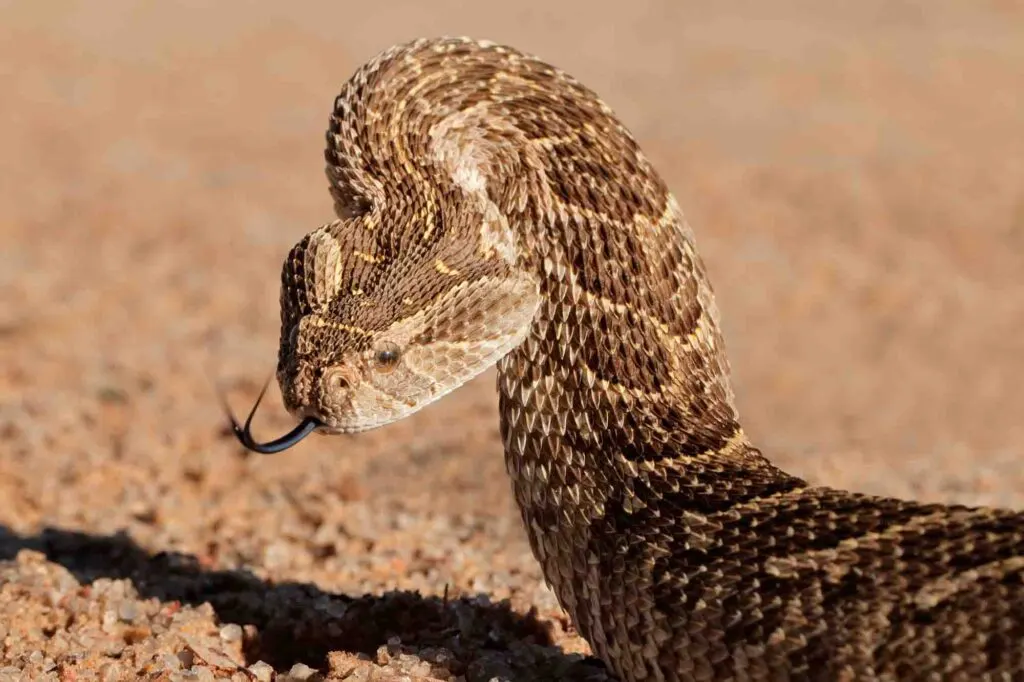
Puff adder, also known as common or African puff adder, is native to Africa and Western Arabia. These snakes love savannahs and grasslands.
The puff adder is widely distributed, and therefore, it is one of the reasons for the high amount of fatalities from its bite.
The venom of the puff adder has a cytotoxic effect and, hence, is one of the most venomous snakes in the world, with an LD50 of 0.4-2mg/kg.
The venom yield of this particular snake is between 150 and 350mg. Typically, the bite causes tissue damage, necrosis, and even gangrene that can lead to the loss of fingers and limbs.
20. South American Bushmaster (Lachesis muta)
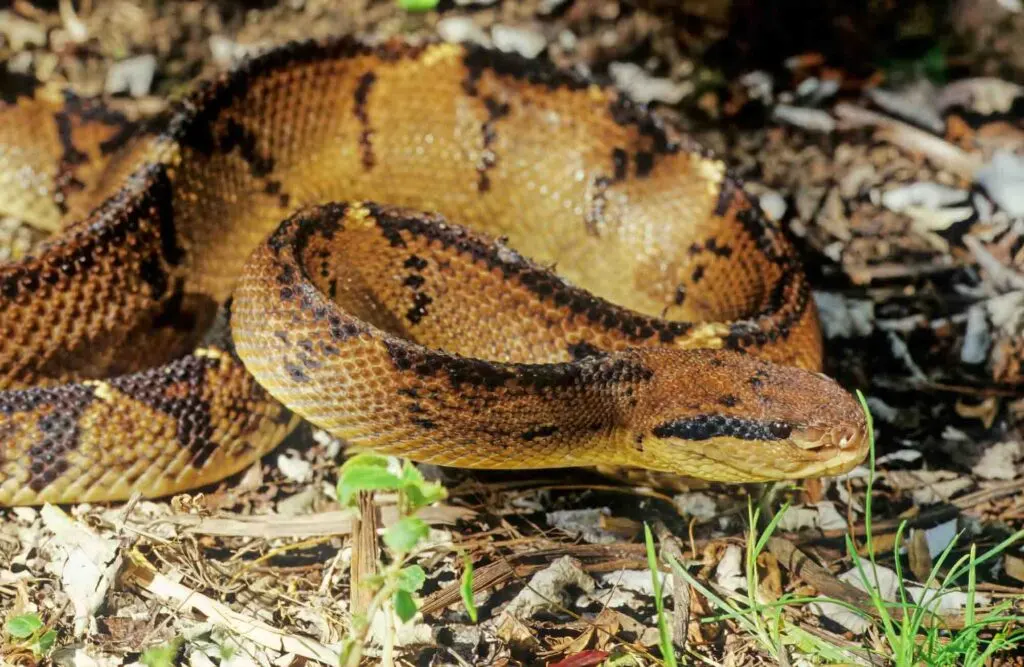
The South American Bushmaster is also known as the Atlantic bushmaster and is mainly found in the territory of South America and the Caribbean.
Those snakes are one of the most venomous snakes in the world, as the LD50 value of this particular snake species is 1.5mg/kg. The venom yield of the Lachesis Muta is between 64 and 233 mg.
The venom causes incoagulable blood, so a hemorrhagic state, and affects the overall tissue and nervous system.
19. King Cobra (Ophiophagus hannah)
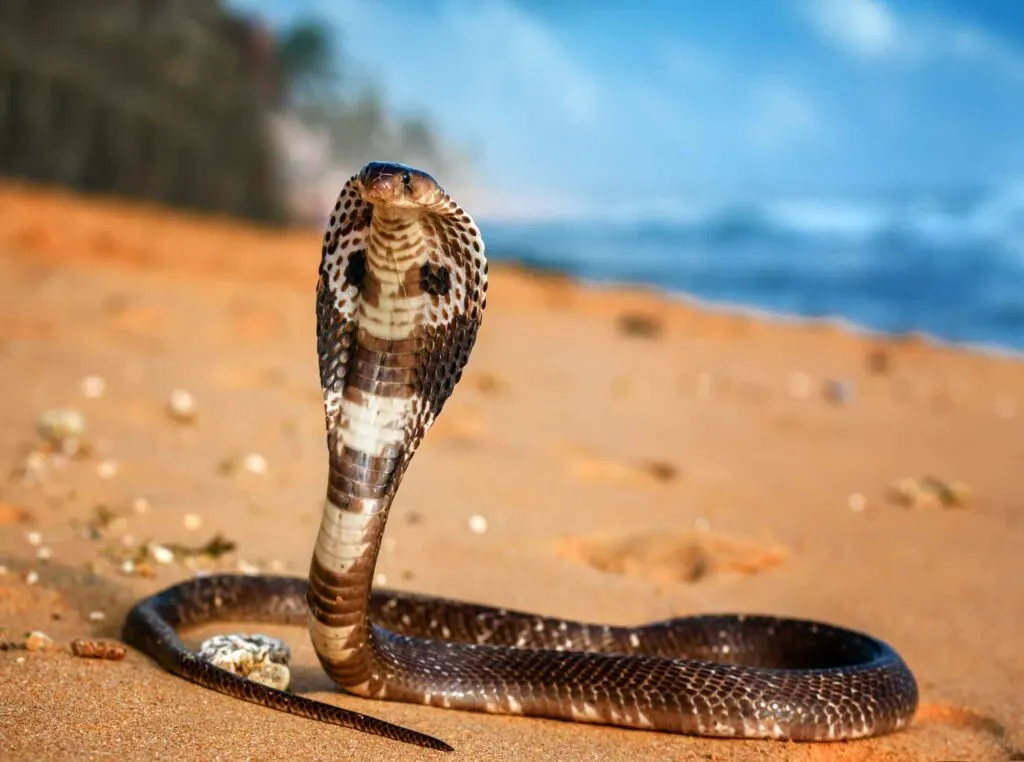
The king cobras, some of the deadliest snakes in the world, can be found throughout the Malay Peninsula, in northern India, eastern Indonesia, southern China, and the Philippines.
The king cobra is a dangerous snake that can suffocate humans very quickly. The high amount of potent neurotoxins in the venom of king cobras’ bite, about 400-500mg, prevents the body’s nerves from functioning.
With LD50 toxicity of 1.09mg/kg, a king cobra bite is enough to cause 20 human deaths or even of an elephant, despite the fact that their venom is not the most deadly among venomous snakes.
The respiratory centers in the brain are impacted by king cobra venom, leading to cardiac and respiratory failure.
18. Gaboon Viper (Bitis gabonica)
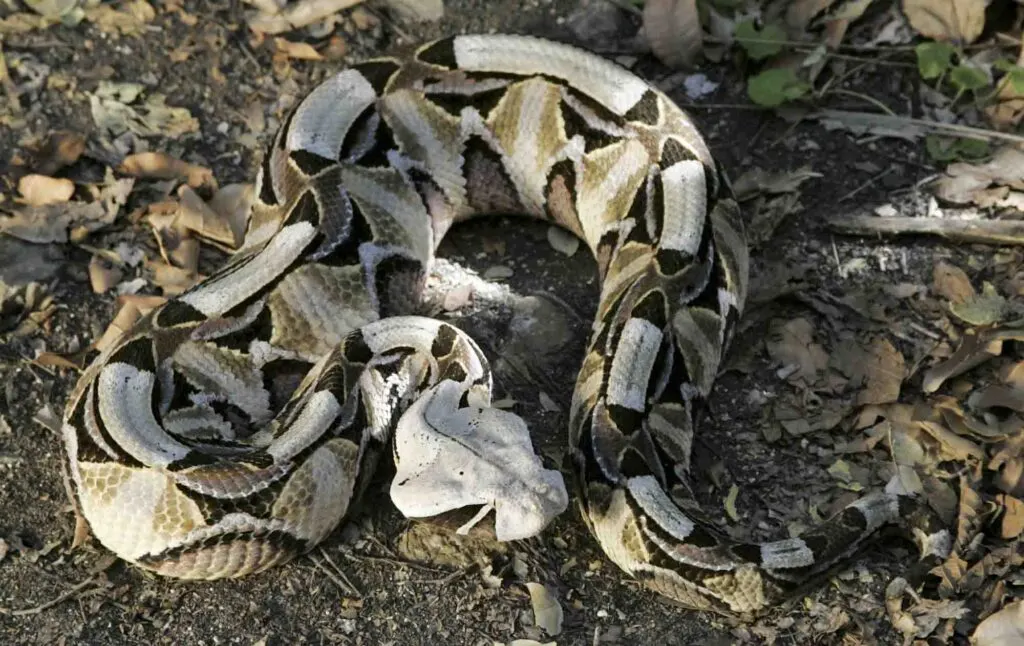
This particular specie is the snake with the highest venom yield and, therefore, is considered to be one of the most venomous snakes in the world.
The enormous venom glands make it possible to inject a large quantity of venom. In a single bite, this snake injects venom amounts of 450-600mg. LD50 of this particular venomous snake species is 0.8 mg/kg.
Bite of gaboon viper in humans causes swelling, pain, blistering, and shock. Then it is followed by necrosis, convulsions, dyspnea, and hypotension.
The gaboon viper snake is native to the African rainforests and savannas.
17. Common Death Adder (Acanthophis antarcticus)
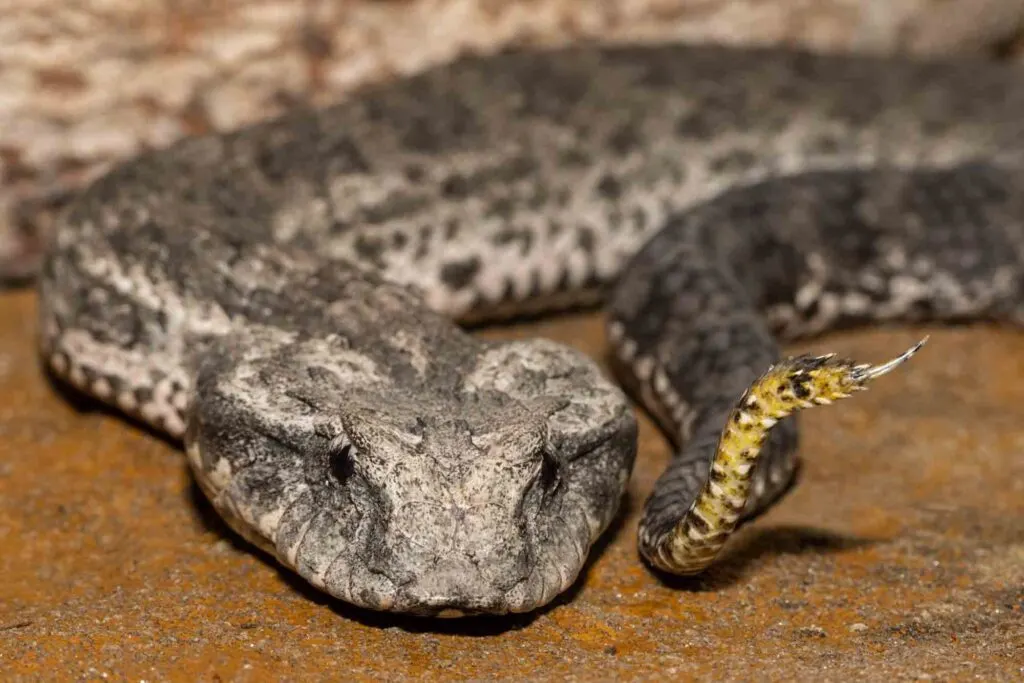
The common death adder is native to the eastern part of Australia and is characterized by an arrow-shaped head and a stocky body.
The narrow tail tip has a brief spine at the end. The back is often distinguished by lighter bands and can range in color from grey to reddish-brown.
Those venomous snakes prefer to live in coastal heaths, woods, and wet and dry eucalyptus forests.
Venom-wise, those fierce snakes can deliver between 40-100mg of highly toxic venom with an LD50 of 0.4-0.5mg/kg.
The death adder, however, is very hesitant to bite people and often only does it in self-defense.
They have the quickest strikes in the world, though. In only 1/10 of a second, they may attack, bite, inject their toxic venom, and then strike again from a defensive stance.
Some deadliest snake lists name the common death adder in the top 10.
16. Chinese Copperhead (Deinagkistrodon acutus)
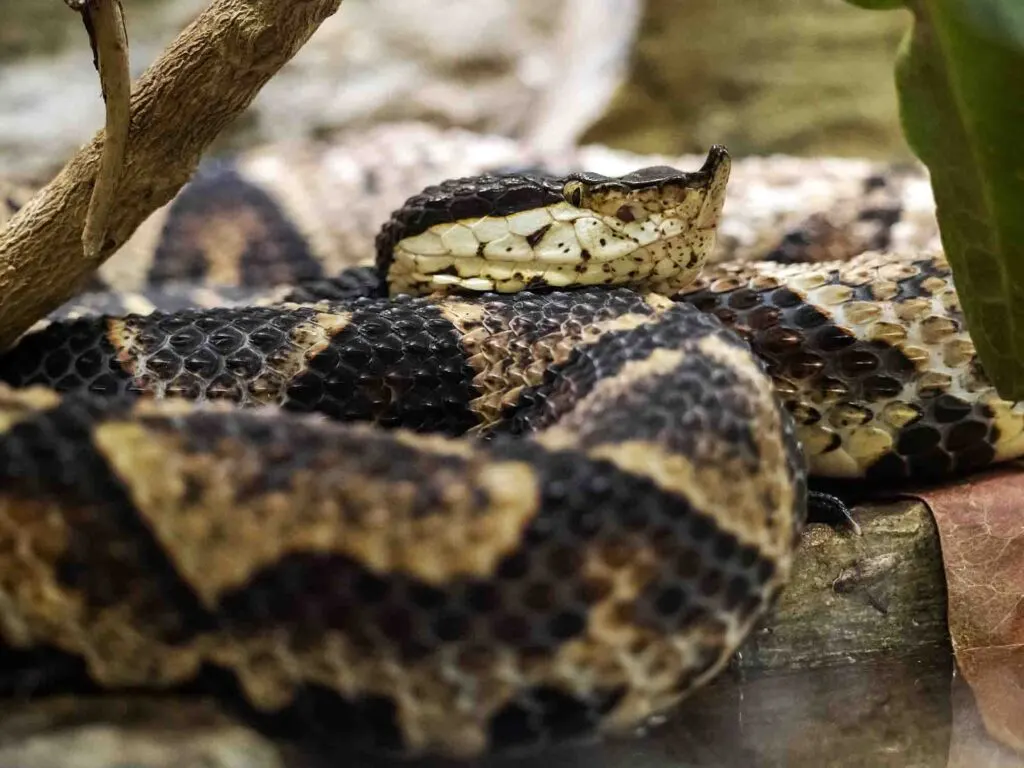
Chinese copperhead is endemic to Southeast Asia, and currently, there are no subspecies of this genus recognized.
There is a belief among local people that after this particular snake bite, the victim can only walk 100 steps, and then one passes immediately.
That is why the Chinese copperhead is also called “Hundred Pacers.” So, can you imagine how venomous it is, right?
However, the fatalities are not as usual, and generally, the bite causes gangrene and loss of fingers or limbs. LD50 of this particular snake is 0.38 mg/kg.
15. Black Mamba (Dendroaspis polylepis) – One of The Most Venomous Snakes in Africa
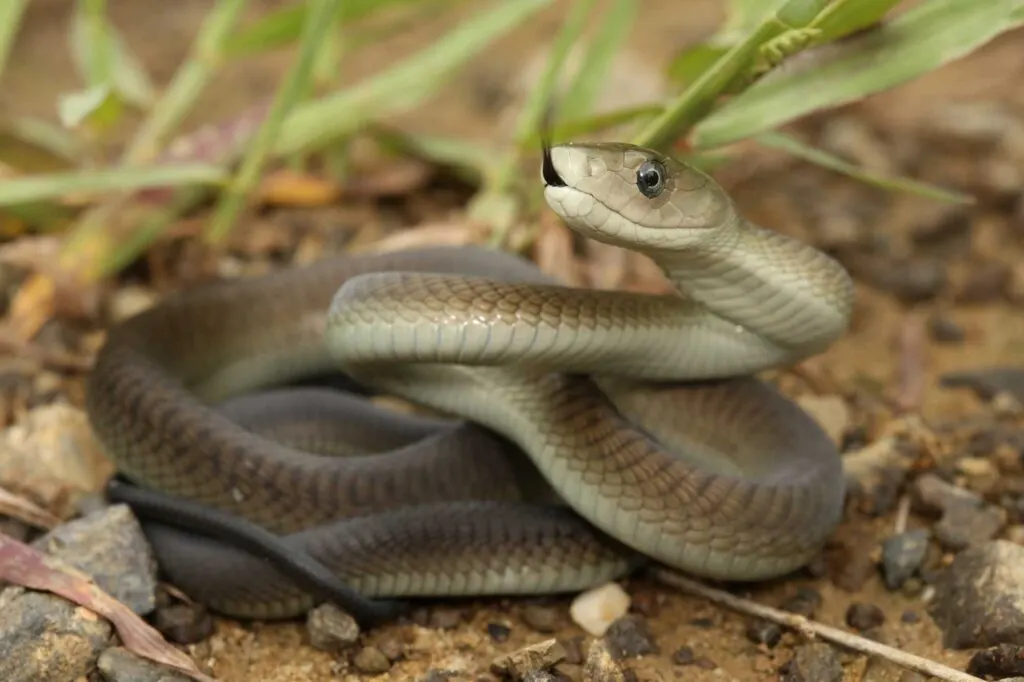
The black mamba is one of the most feared African snakes (in fact, it makes the list of most dangerous animals in Africa) because of its high speed, threatful venom, and aggressive demeanor. It is also one of the most hazardous creatures out there.
Like other snakes, the mamba will want to avoid conflict with people, but if forced into a corner, they are more than willing to defend themselves and engage in combat.
Something that makes these snakes even more dangerous is their speed: black mambas are one of the fastest snakes in the world, reaching a speed of 11.8 miles per hour.
As for their potent venom, it scores 0.32mg/kg in the LD50. The black mamba delivers an average of 100mg of venom per bite.
14. Belcher’s Sea Snake (Hydrophis belcheri)
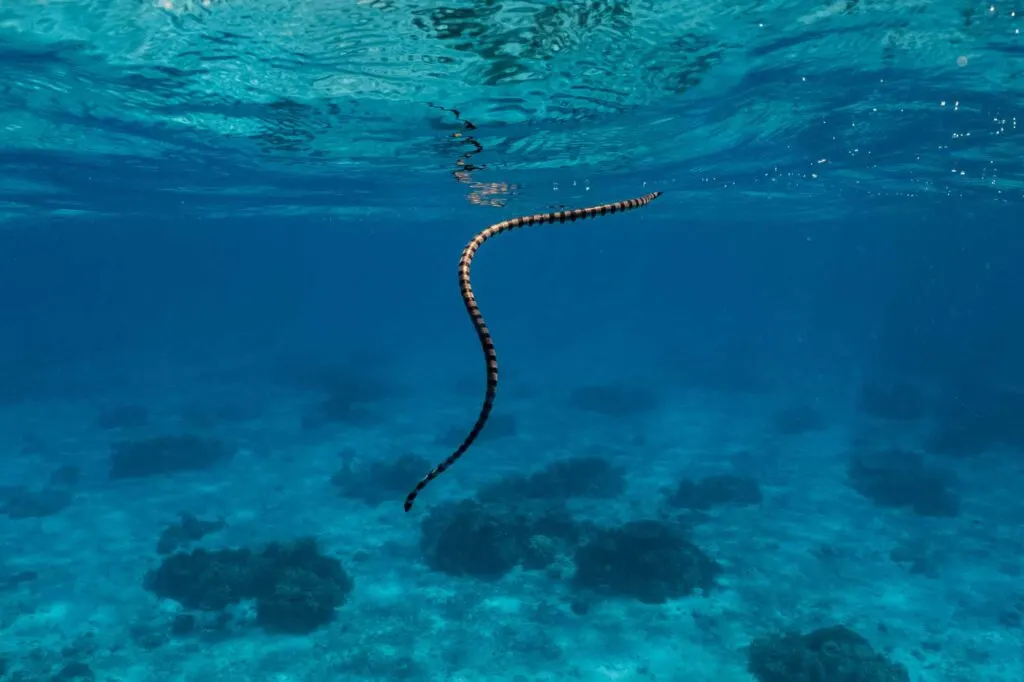
Belcher’s sea snake, also known as the faintly banded sea snake, is one of the most dangerous snakes from the elapid sea snake family.
The venom of this snake is not studied well, however, the approximate LD50 is 0.24mg/kg.
Belcher’s sea snake is found in the tropical regions of the Indian Ocean, Thailand, Indonesia, New Guinea, and the Philippines.
13. Beaked Sea Snake (Hydrophis schistosus)
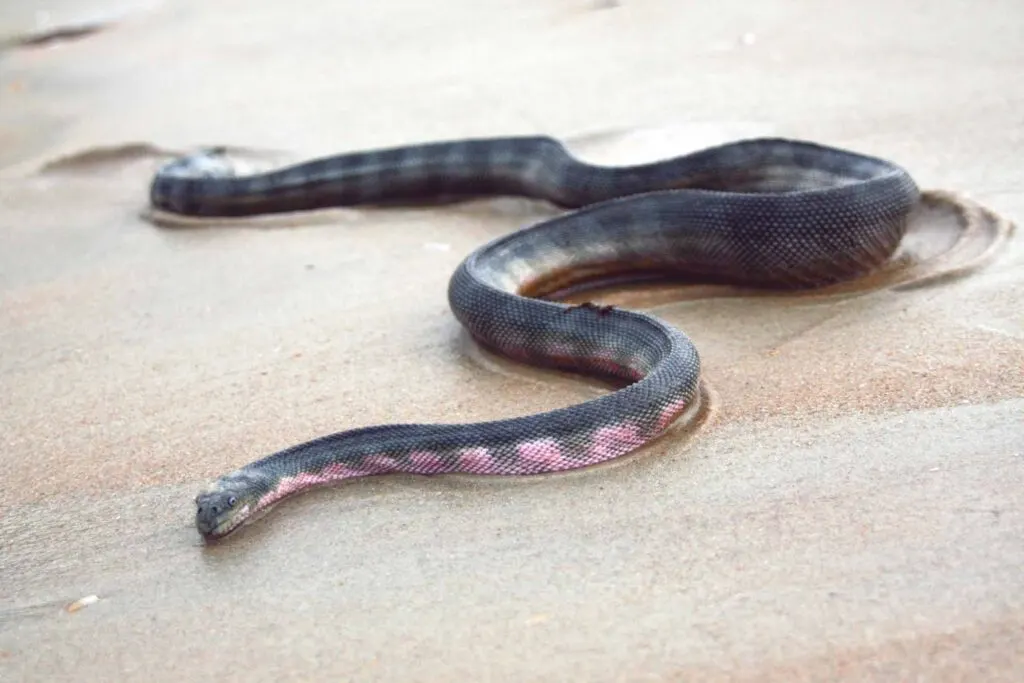
Baked sea snakes come with various names and are also known as hook-nosed sea snakes and common sea snakes.
This particular one is among the deadliest snakes because of the high level of venom. More than 50% of the bites, if left untreated, are fatal.
The beaked sea snakes are native to the tropical environment of Indo-pacific.
The venom of the beaked sea snake consists of powerful neurotoxins and myotoxins, and it has the LD50 value of 0.164mg/kg, which is pretty high.
Typically, this snake has a venom of 7.9 to 9 mg in one bite, whereas the lethal dose is approximately 1.5mg.
12. Russell’s Viper (Daboia russelii)
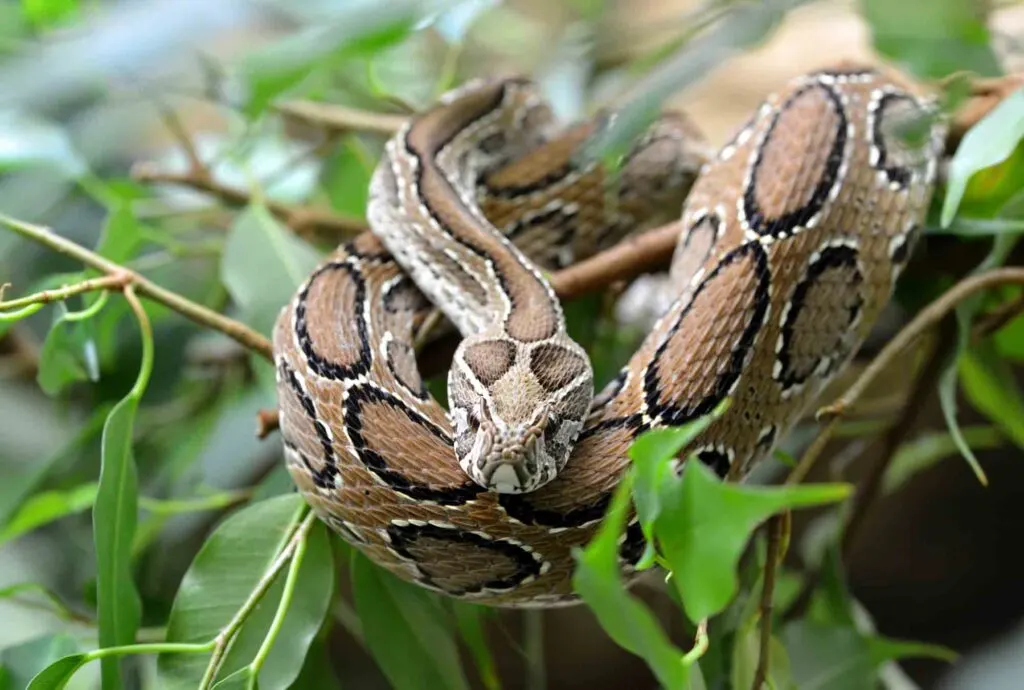
Russell’s viper is among the most venomous snakes in the world and is found in Sri Lanka, Burma, and India.
The LD50 of this particular snake venom is 0.133mg/kg. The lethal dose of venom for humans is approximately 40 to 60 mg, which can be injected even in one bite.
The average amount of venom that can be delivered in one bite is 130-250mg. The Russel’s vipers bite can cause kidney failure and blood clotting.
11. Fer-de-Lance (Bothrops atrox) – Most Venomous Snake in Brazil
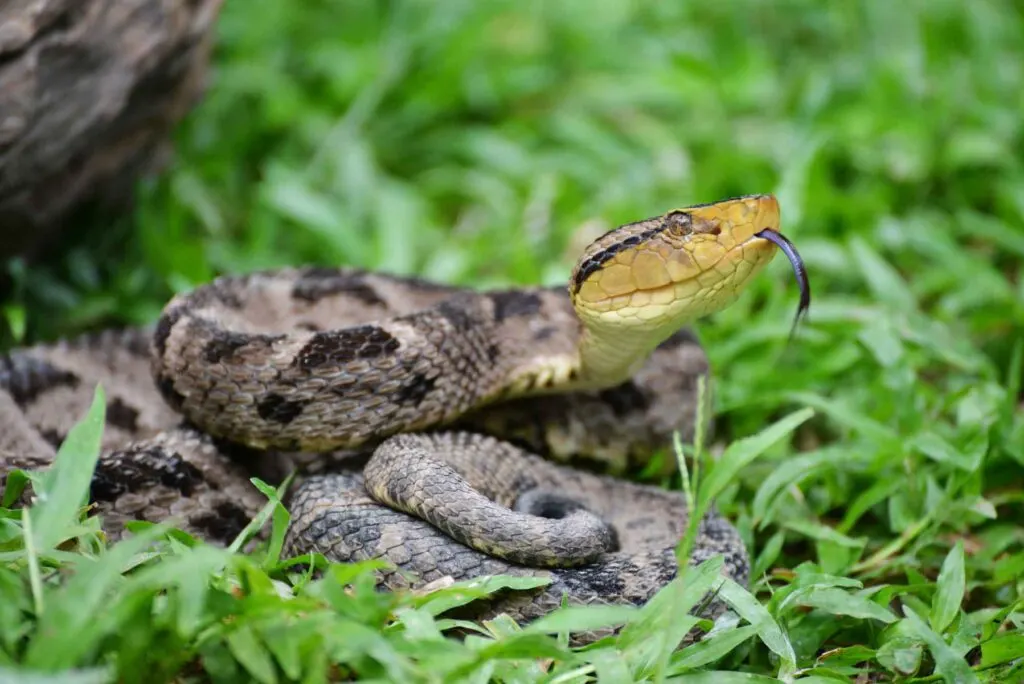
Fer-de-lance snakes are native to Central and South America. They have flattened heads and grow approximately 5.9 feet long.
Those are among the most venomous snakes in the world. Typically, the venom that they inject into the prey is very painful, necrotizing, and in most cases, deadly. Fer-de-lance can bite while having the head raised from the ground.
The LD50 strength of the venom of the fer-de-lance is 1.1 to 4.9mg/kg. The average amount of venom that gets injected is around 105mg.
10. Saw Scaled Viper (Echis carinatus)
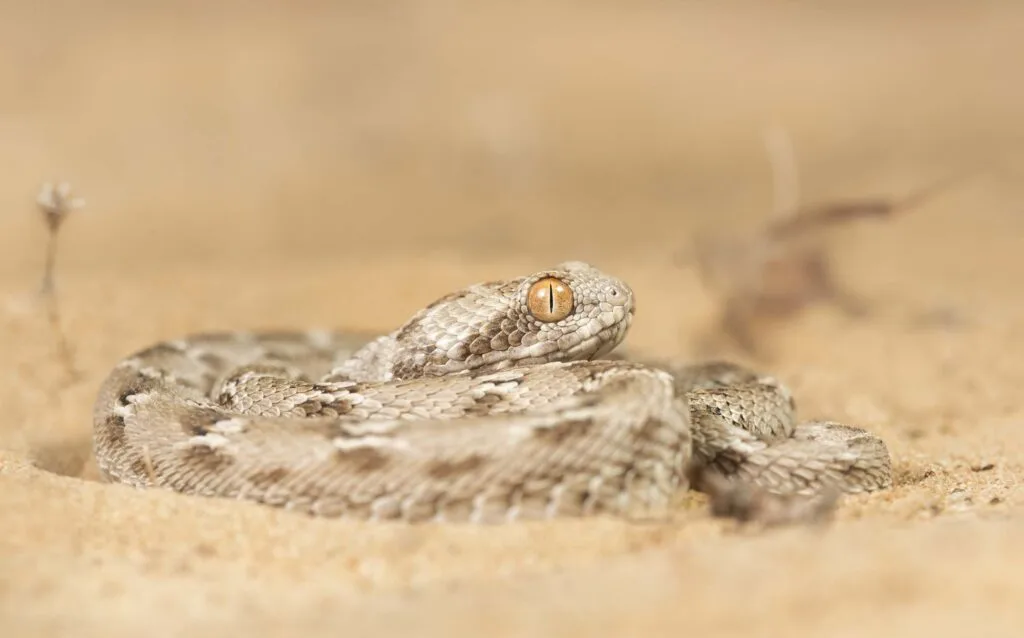
Saw scaled vipers are among the most venomous snakes in the world and are mainly distributed in the areas of Central Asia and the Middle East.
They are not rare, and because of their frequent occurrence and because of inconspicuous temper, they are responsible for many deaths.
With an LD50 of 0.24 mg/kg, the saw-scaled vipers can inject up to 12mg of venom in one bite. However, the lethal dose is considered to be 5mg.
9. Stiletto Snake (Atractaspis bibronii)
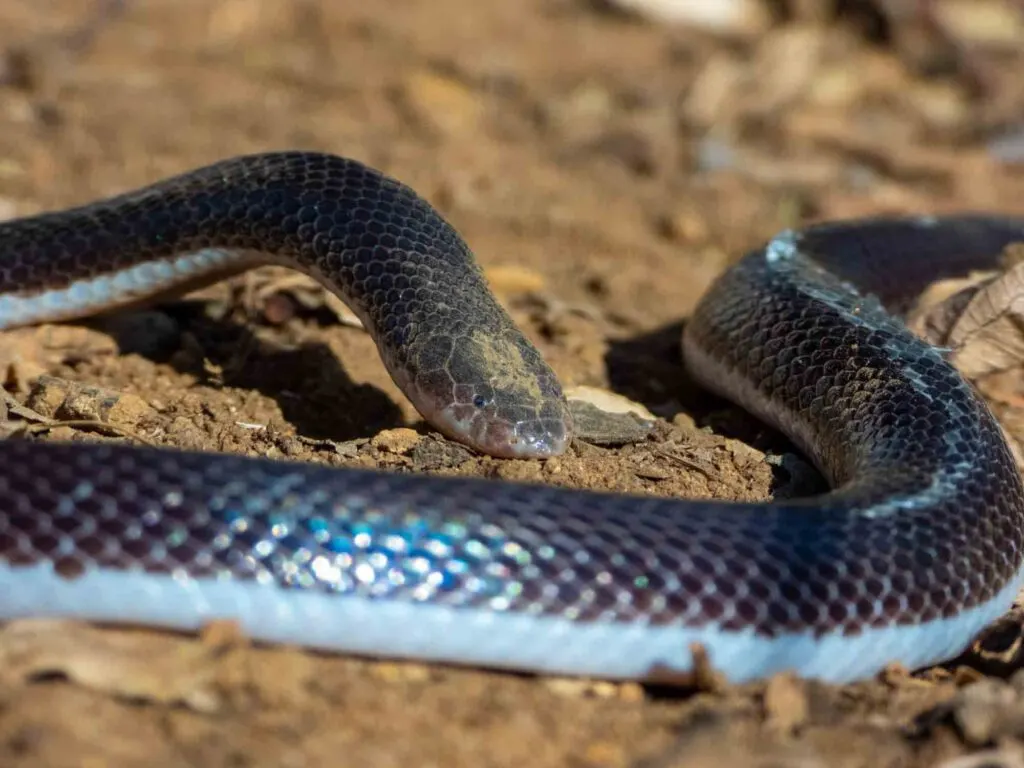
Stiletto snake is found in Africa, and they can bite even if they are held by the neck.
The symptoms that follow a bite are often pain, swelling, blistering, necrosis, and lymphadenopathy.
The fatality from its bite has not been recorded, but if left untreated, the victim will most likely lose the fingers or affected area.
8. Mojave Rattlesnake (Crotalus scutulatus) – The Most Venomous Snake in America
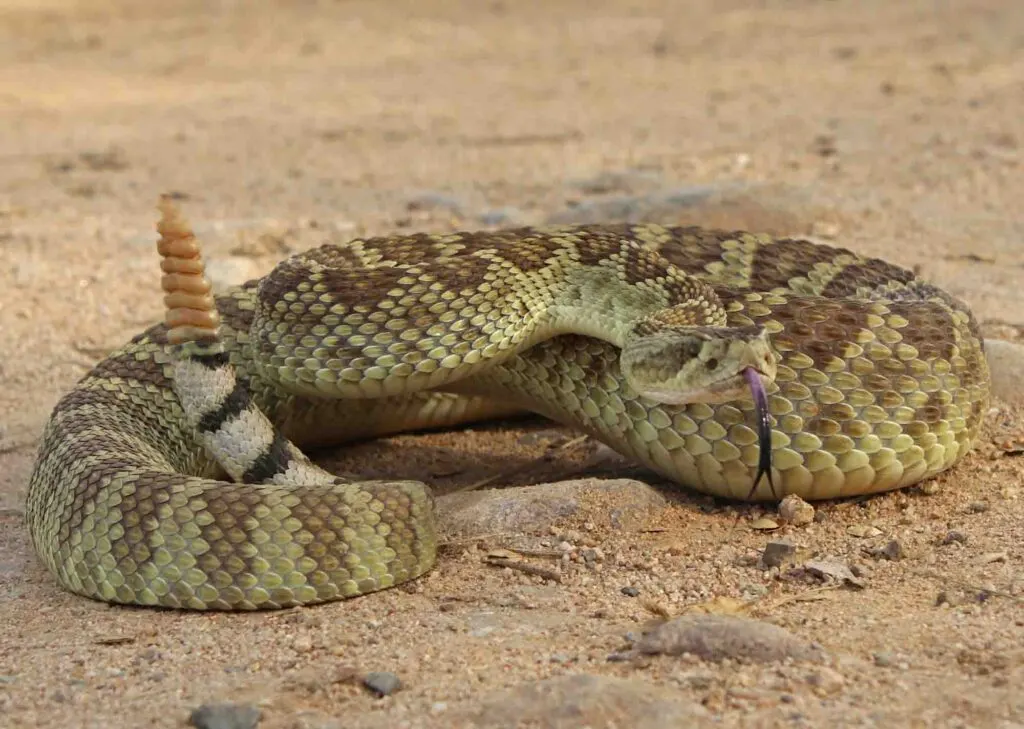
The Mojave rattlesnake is one of the deadliest snake-pit viper species in the world. The snake is native to the Southwestern USA and Mexico.
The venom of Mojave rattlesnake is a mix of neurotoxin and hemotoxin. Therefore, it is considered to be one of the lethal rattlesnake venoms.
Neurotoxins affect the brain and nervous system, and hemotoxin destroys muscles and tissue. An average lethal dose of the venom, LD50 is 0.23mg/kg, whereas the lethal dose for humans is between 10 to 15 mg.
7. Banded Krait (Bungarus fasciatus)
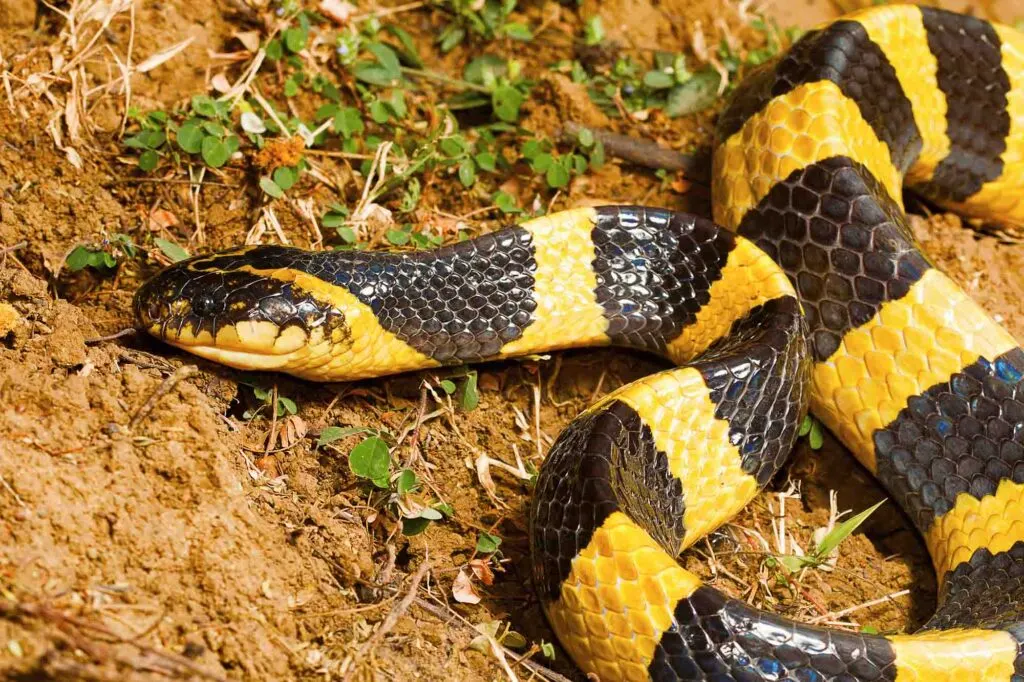
The banded krait is a pretty shy snake despite having extreme venom. Nevertheless, coming into a banded krait in the wild is not something you want to do. This particular snake is found in Indian Subcontinents and Southeast Asia.
The banded krait’s venom is so powerful that it has an LD50 value of around 108mg/kg. The amount of venom that is delivered on each bite varies between 20-114 mg.
This particular snake has a very painful bite, and the venom directly attacks the central nervous system.
6. Boomslang (Dispholidus typus)
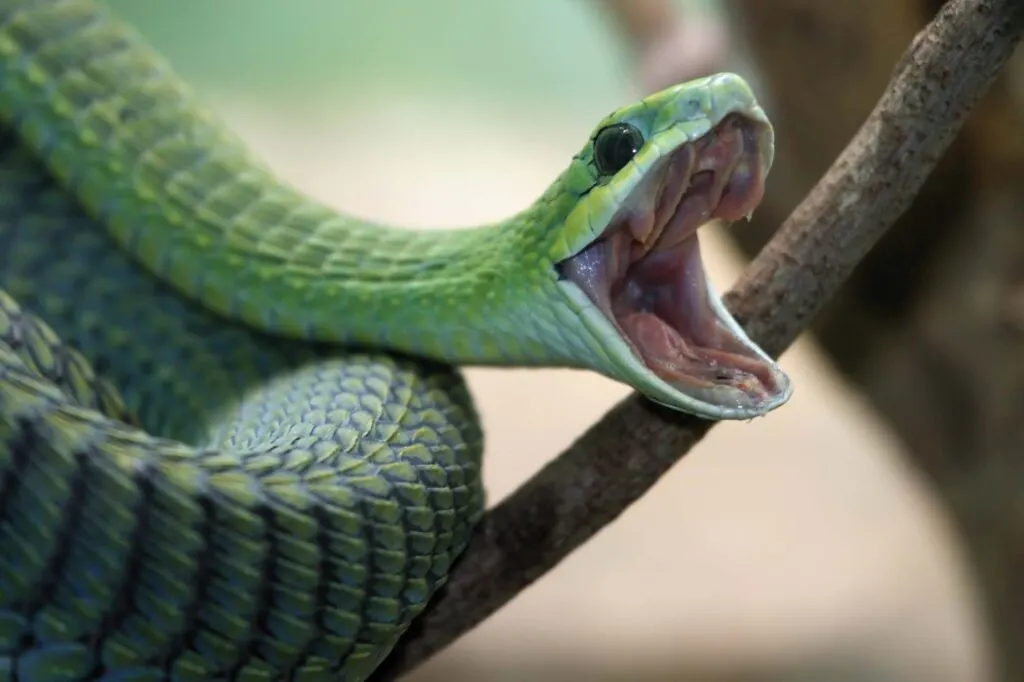
Boomslang snake is found in Sub-Saharan Africa and generally is widespread in Namibia, Botswana, Eswatini, Mozambique, and South Africa.
The average boomslang injects 1.6 to 8mg of venom in one bite. LD50 of this particular snake is 0.1mg/kg, therefore, for humans, the death dose would be 2 to 3 mg of the venom.
Even though they are one of the most venomous snakes in the world, the boomslangs are pretty timid.
5. Blue Krait (Bungarus candidus)
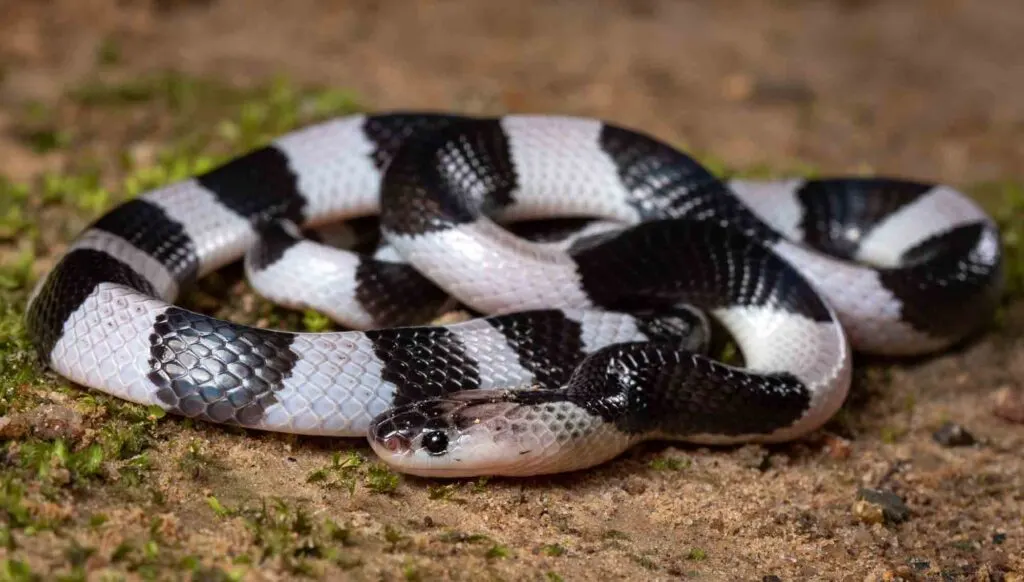
Blue kraits, also known as Malayan kraits, are found on the territories of Malaysia, Indonesia, Vietnam, Laos, Thailand, Myanmar, and generally southeastern Asian countries.
Blue krait is considered to be one of the most dangerous snakes, with a mortality rate of 70% of humans if left untreated.
This particular snake injects the venom with an LD50 amount of 0.1mg/kg. The average venom amount that gets injected is 5mg, while the lethal dose is just 1mg.
4. Tiger Snake (Notechis scutatus)
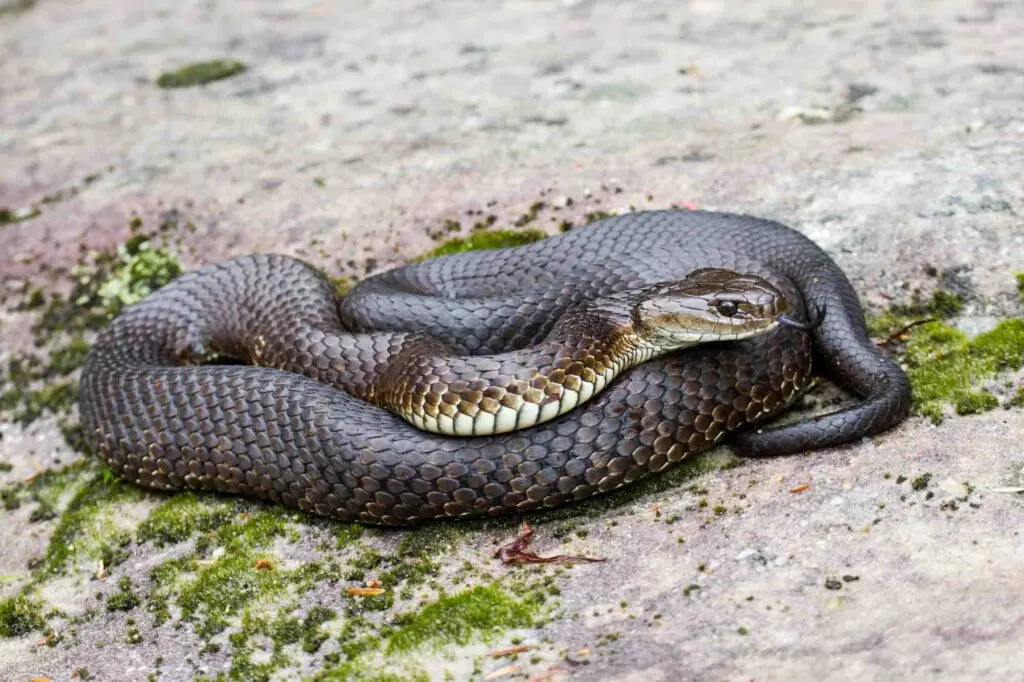
Tiger snakes are one of the most dangerous snakes of all and are highly venomous. Those creatures are native to Southern Australia and are spread on Tasmania’s coastal islands.
The different species come with various color patterns and have colors that somewhat resemble tigers.
Venom has coagulants, hemolysins, myotoxins, and neurotoxins in it, therefore, causing severe symptoms such as breathing difficulty, renal failure, and paralysis.
The mortality rate of the bite is up to 60%. This dangerous snake has an average venom yield of 35-65mg, whereas the lethal dose is 3mg. The LD50 of the tiger snake is 0.12mg/kg.
3. Coastal Taipan (Oxyuranus scutellatus)
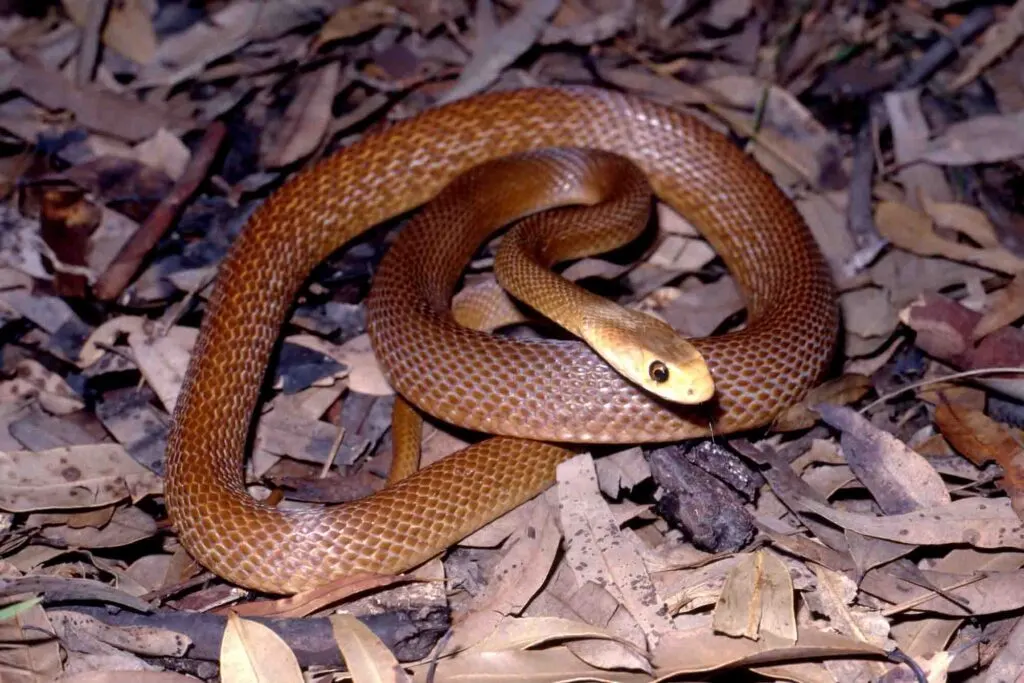
The coastal taipan may be found throughout Australia’s northern and eastern coastal regions as well as the neighboring island of New Guinea.
They are Australia’s longest poisonous snakes. They can pounce with great speed, deliver many bites, and even inject the venom in amounts of up to 120mg, but as much as 400mg has been recorded. The LD50 value of the Coastal Taipan’s venom is 0.106mg/kg.
The snake stops when it detects prey, then lunges forward and snaps multiple fast bites.
Then let go of the victim and wait for the poison to work before eating. Without a doubt, they are one of the most venomous snakes in the world.
2. Eastern Brown Snake (Pseudonaja textilis) – The Most Venomous Snake in Australia
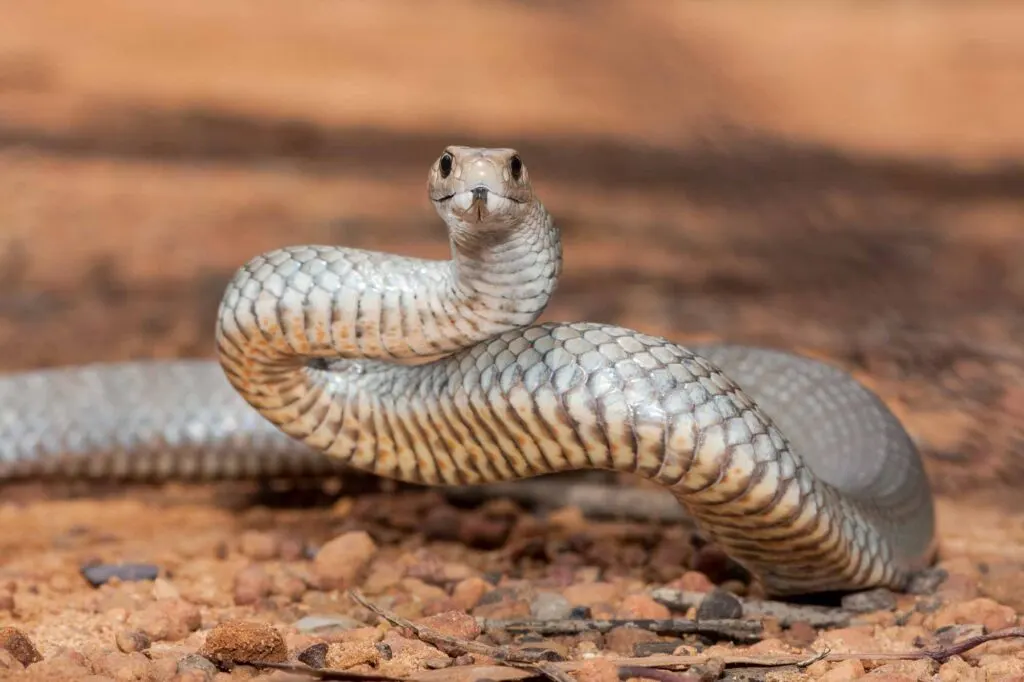
The solitary, swift-moving eastern brown snakes are found in Australia, Indonesia, and Papua New Guinea.
They have a slim form, may reach lengths of up to 6,5 feet, and lack a neck transition.
The eastern brown snake, as its name implies, comes in a variety of hues, from light brown to black, and its underbelly is creamy yellow.
This snake is responsible for 60% of snakebite deaths in Australian territory and is considered to be the second most-poisonous snake worldwide.
This snake raises its head from the ground, then coils into an ‘S’ form and bites the prey, which is frequently fatal. The primary effects of venom on the circulatory system are blood loss, cardiac arrest, and cardiovascular collapse.
The LD50 score of Eastern Brown Snakes is 0.03mg/kg. On the average bite, the brown snakes inject venom of 5 to 155mg.
1. Inland Taipan (Oxyuranus microlepidotus) – The Most Dangerous Snake in the World
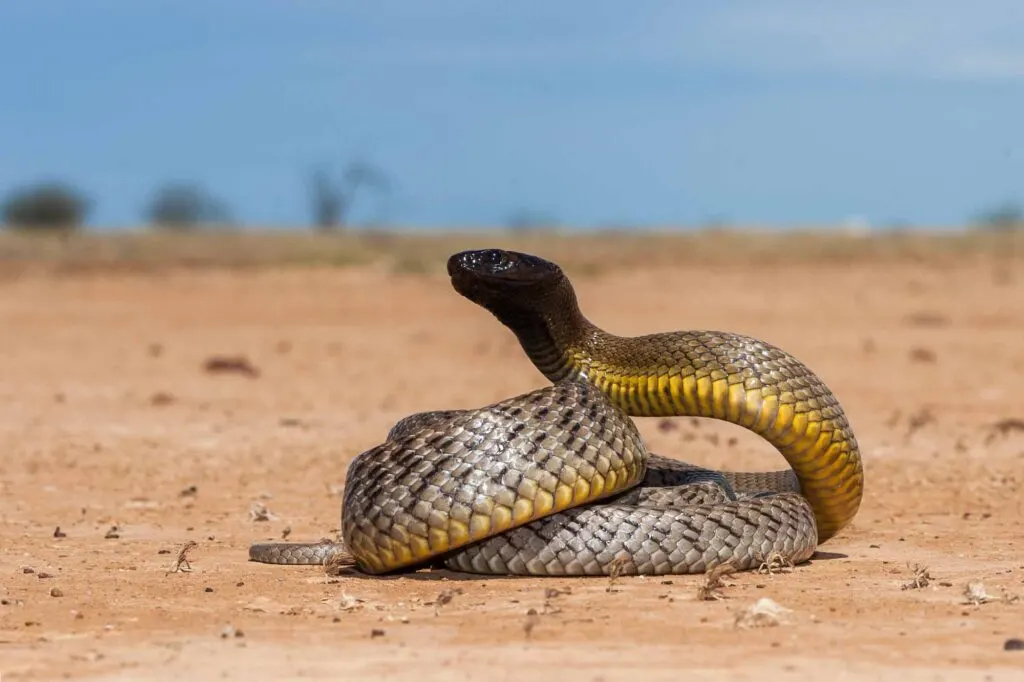
The inland taipan, also known as “the furious snake,” is considered to be one of the most venomous snakes in the world. Those vicious snakes are native to central-east Australia.
When the venom enters the blood system, it causes a hemorrhage, and as a result, breathing gets inhibited.
The bite of these deadly snakes may kill a person in less than an hour and is fatal in approximately 80% of untreated cases. Those snakes have an LD50 value of 0.025mg/kg and inject 44mg-100mg of venom per bite.
